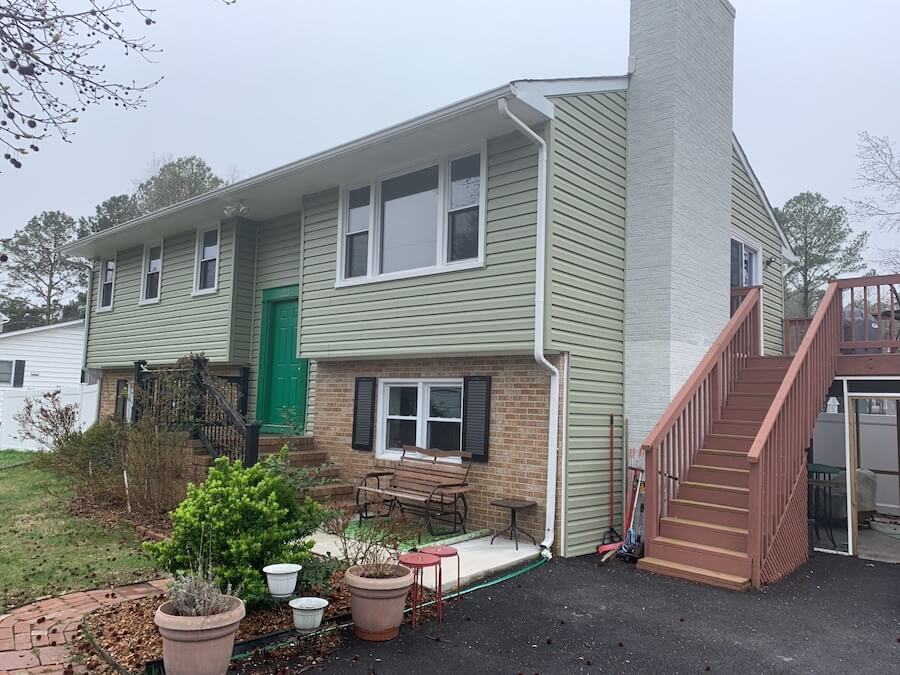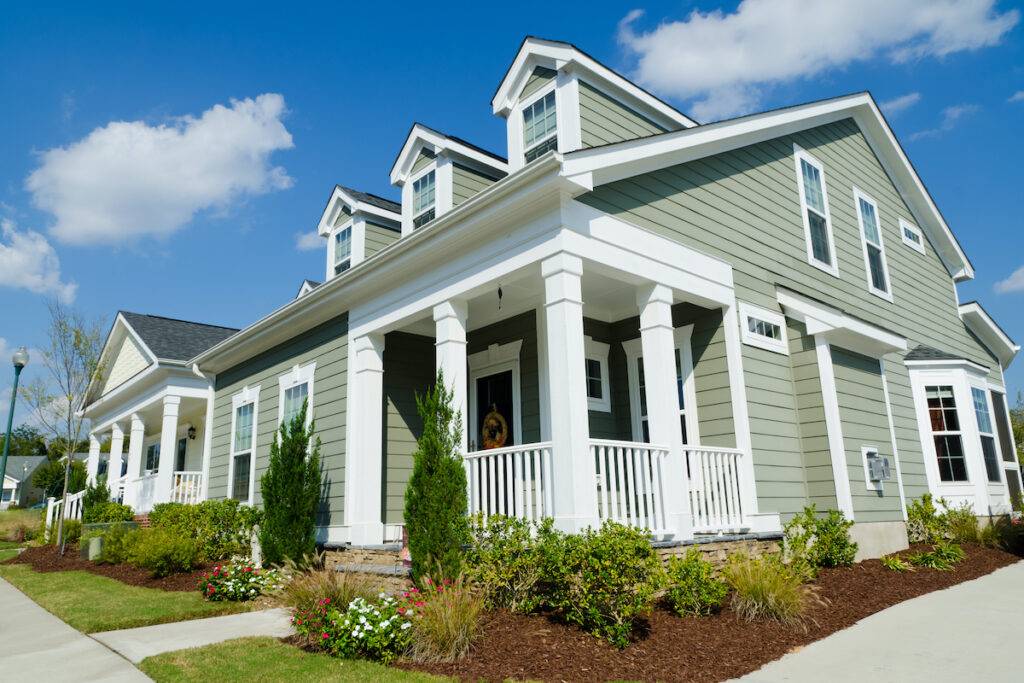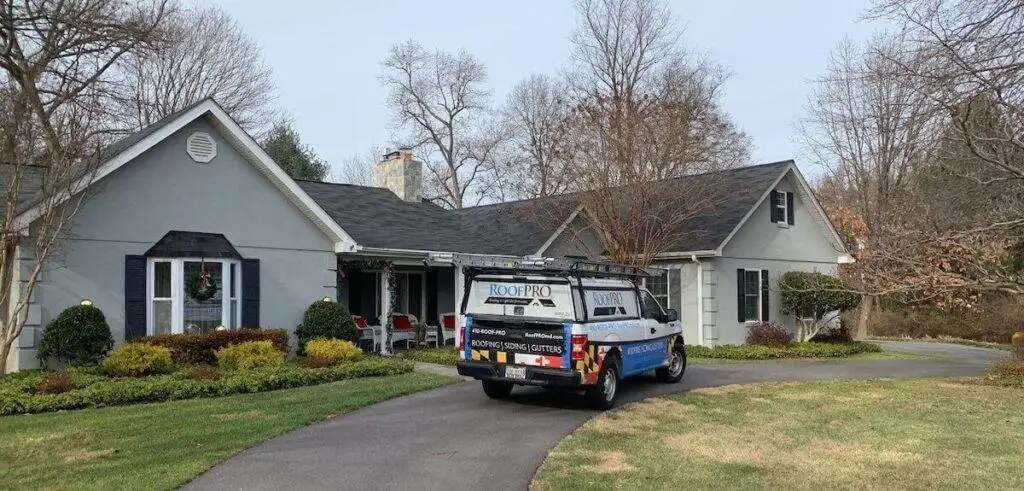Many people across the US opt for vinyl siding because it is a highly durable, cost-effective, and low-maintenance material for their home’s exterior. However, like all exterior materials, vinyl siding can still experience weather damage and other issues. Cracks, holes, or warping may develop over time – this guide describes how you can repair the damaged areas on vinyl siding!
Reach out to our team at RoofPRO today for more information and a free inspection!

Common Problems with Vinyl Siding
Even though vinyl can be seen as a rugged and low-maintenance type of exterior, vinyl siding is not exempt from withering away with time and the elements. For a homeowner, it’s vital to detect siding problems early to ensure that damage does not get worse, whereas replacing the siding entirely will entail a more significant cost! This next section will discuss some common issues usually faced with vinyl siding, their causes, and possible impacts.
Cracks or Small Holes
Tree branches, hail, or small objects can hit vinyl siding over time, resulting in small cracks or even tiny holes. These smaller punctures can allow water to pass behind the siding, expose the wall of the house, or make the siding more susceptible to high winds. With these smaller holes and cracks, you can often replace a small section of the siding, and you’ll be good to go. But keep in mind that if it’s hail damage, you might have more, at which point it could make sense to place a claim with your insurance.
Warping
Extreme heat can cause vinyl siding to warp. This can happen from a nearby grill, but also from a more unusual source: reflected sunlight. When sunlight bounces off a neighboring window, it can intensify the heat hitting your house and lead to warping. Warped siding not only looks terrible on your house but can also reduce the strength of your home’s protection from the elements! In these cases, entire sections of siding must be replaced to remedy the issue.
Wind Damage
Strong winds can rip vinyl siding off your home. While powerful gusts are a culprit, improper installation can also play a role. If siding isn’t securely clipped together or nailed properly, even moderate winds can cause panels to loosen and potentially detach. If one piece comes off, the rest of that wall becomes highly susceptible to more damage, so it’s imperative to have it repaired as fast as possible.
Flashing Around Windows and Doors
Color Fading or Deterioration Over Time
While designed to hold color for years, fading can occur if the house is consistently exposed to bright, prolonged sunlight and bad weather conditions for many years. The result may be that your home’s siding looks older and less attractive than it could be, which could directly affect its aesthetic appeal and value when it comes time to sell.

How Can You Patch or Repair Vinyl Siding?
When minor damage, like a hole or crack, occurs to your vinyl siding, you will likely want to repair it yourself. Fortunately, small areas of vinyl siding can be patched or repaired relatively easily, requiring few tools and materials! This next section will take you through the repair process for your vinyl siding step by step, allowing you to care for these minor problems before they develop into more extensive damage. By following these general guidelines, your siding can be returned to good working order and, hopefully, avoid moisture penetration and structural damage to your home!
Caulk or Re-Installation of Siding
Don’t sweat the small stuff! Minor siding issues like loose panels or failing caulk are often easy fixes. Over time, exterior caulk can crack and lose its seal. Simply remove the old caulk and replace it with a high-quality exterior caulk specifically designed for siding repairs. Interior caulk won’t withstand the elements, so make sure you choose the right product.
Sometimes, a single siding panel might pop out of place. These are usually easy to snap back into position. However, if the panel came loose because of improper installation, you might need a professional. The reason being, to properly fix a loose panel due to bad installation, you might need to remove the siding above it. This allows you to secure the dislodged panel correctly and then reinstall the removed siding piece. For anything beyond simple fixes, it’s always best to consult a professional to ensure a lasting repair.
Using the Right Tools for Your Siding Repair
There is a tool specifically designed for vinyl siding, so if you plan to repair the siding yourself, you’ll definitely need to get one of these. It’s designed with a small hook that enables you to snap the pieces of siding back into place. Just keep in mind that if you’re working with siding in cold temperatures or if the vinyl siding is old, it will break easier. So you’ll want to perform your repair with care. If your siding seems rough or you’re unsure about the repairs, call in a pro. A little caution can prevent bigger problems down the road!
Matching the Vinyl Siding Type, Color, and Manufacturer
Replacing a section of siding can get a little tricky when it comes to matching the exact type and color. Manufacturers often discontinue entire siding lines, making finding the exact match a real challenge. To start your repair, you’ll need a color sample from the manufacturer—that’s key! But hold on, there’s more! Vinyl siding comes in different styles, like Dutch lap, straight lap, and beaded. Knowing yours is crucial. And lastly, even if the color and style look perfect, panels can have different widths that differ from 4 to 6 inches. That’s why measuring the existing panel’s face is essential for a seamless repair.
House Wrap and Flashing
When you’re repairing your siding, take a look behind the siding and see if you have adequate house wrap. If not, you’ll need to install it. House wrap is what actually waterproofs your home. Without it, moisture and water will rot the wood behind the siding and get into your home. Additionally, if you’re working near a window or door, you’ll want to make sure that the flashing around them is present. You’ll need to make sure the sides have a specially designed flashing tape to cover the transition and the tops have z-flashing in place.
Vinyl Siding Repair vs. Replacement
Although minor repairs can sometimes be a DIY job for homeowners, some more extensive fixes may require the hand of a professional. If you’re not sure about whether to repair or replace vinyl siding, you’ll want to keep these things in mind:
Age of your siding: If your vinyl siding is over 20 years old and displays widespread damage, replacement is more economical than multiple repeated repairs.
The extent of damage: A repair may be good enough if your siding has minor and localized damage. But if it is severe or extends over a large area, you could be forced to replace the affected sections or even the entire wall of siding.
Cost of repair vs. replacement: Compare the cost of replacing the damaged siding against the repair cost. If the repair cost is close to or exceeds the replacement cost, choosing a new siding installation would be wiser.
For appearances: Patches and repairs are likely to be visible, especially if the color or texture of the material does not closely match your existing siding. Replace the damaged portion of the siding to maintain a consistent look across your entire home.
When Should I Replace My Siding Outright?
While some issues can be addressed with repair services, there are situations where replacing the whole vinyl siding material is the best action to take. As stated above, it’s essential to consider this measure when the following applies.
• Your siding has exceeded 20 to 30 years and generally shows widespread wear.
• Your cladding is widely damaged and occupies a significant fraction of your dwelling’s exterior area.
• You want to increase curb appeal and value as you sell your home.
• Your energy bills are always high, and this is because your siding may need better insulation.

RoofPRO is a Top-Rated Siding Contractor for Maryland Homeowners
If you are dealing with damaged vinyl siding or possibly considering complete siding replacement, working with a reliable and highly experienced contractor is critical. For top-rated home improvements in Maryland, choose our team at RoofPRO!
Trusted Solutions for Siding, Roofing, Windows, and More
RoofPRO is proud to provide complete home improvement solutions; whether it is a minor repair or a total replacement of your home’s siding, roofing, or windows, our well-experienced professionals are prepared to perform the work with precision and care. We use only premium materials and cutting-edge techniques that produce sturdy and great-looking work for years to come.
Local Experts Since 2004
Since 2004, RoofPRO has been around to serve home and business owners across Maryland with dedicated expertise! We are committed to customer satisfaction and quality work, which has led to our excellent reputation for being a trusted contractor!
Contact Us Today for a Free Inspection and Estimate
If you are experiencing problems with your vinyl siding or just thinking about a general home renovation, feel free to contact our team at RoofPRO for a free estimate. Our team will come out to review your home’s exterior, offer expert advice, and give you a complete quote on the necessary work. Rest assured, with RoofPRO, your property is in good hands!


